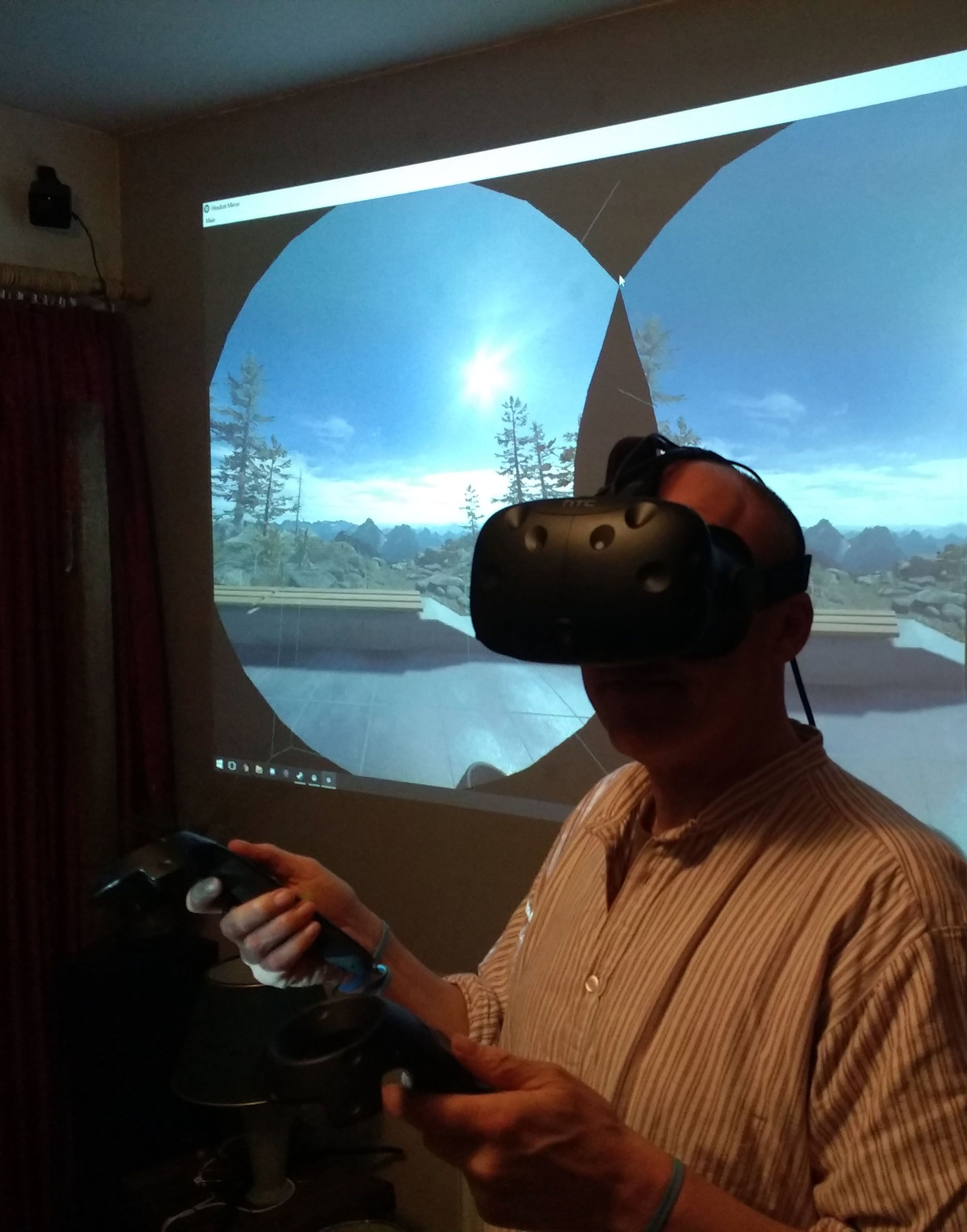
I’m often accused of being on another planet. This week you could say I have been in another dimension.
My lad got himself one of those virtual reality headsets to play with and I have spent a bit of time with it over my head. All in the name of research of course. There’s a comfortable headset, motion controllers, and external sensors for setting up a virtual room. These allow full 360 degree viewing which makes for a most realistic experience. I am able to move around the room without going out of range and hitting anything solid. You do really feel part of the VR world and so far I have sliced hundreds of watermelon and cabbages and built a few brick walls with an all-enveloping game of Minecraft.
Virtual reality headsets have been used effectively for high end property developments both for the investors and the end purchasers to use before parting with cash. It’s not going to be too long until these systems are used on landscape design. The system is already here for us to fly drones over gardens taking in all of the dimensions and terrain, there’s actually an app that could do that for us. This information can be fed into a design program where the landscaping ideas for the customer can be fed into and then this information can be digitally enhanced for 3D headsets. Customers can actually feel what it will be like to be in their new garden and if my lad has anything to do with the programming it’ll also include a sword for you to be able to chop off all of the daffodils and gain points as you walk along.
Drones
Drones are becoming increasingly popular. The ability to have an HD camera on it has revolutionized filming (every TV programme has that cinematic feel to it now) There was a time when estate agents had to hire someone at great cost with a camera strapped to a helium balloon on a still windless day to float over a property to get an aerial view. Now this can be done any time for under €40 and you get to keep the camera and drone.
Drones can do more than spy on the neighbours, film local landmarks and scare dogs on beaches though. They are starting to be used in a lot of horticultural and agricultural related ways. Aerial vehicles without pilots (UAV’s) have been used since the 1980’s and newer data gathering software is claiming to revolutionise the industry. Some agricultural producers are embracing strategies for producing food, increasing productivity, and making sustainability a priority. Drones, it is said, are seen to be a part of the solution, along with closer collaboration between governments, technology leaders, and industry.
Ways aerial and ground-based drones could be used in agriculture and horticulture:
Soil and field analysis: Drones can be instrumental at the start of the crop cycle. They produce precise 3-D maps for early soil analysis, useful in planning seed planting patterns.
Planting: Startups have created drone-planting systems that achieve an uptake rate of 75 percent and decrease planting costs by 85 percent. These systems shoot pods with seeds and plant nutrients into the soil, providing the plant all the nutrients necessary.
Crop spraying: Distance-measuring equipment—ultrasonic echoing and lasers enables a drone to adjust altitude as the topography and geography vary, and thus avoid collisions. Consequently, drones can scan the ground and spray the correct amount of liquid, modulating distance from the ground and spraying in real time for even coverage. The result: increased efficiency with a reduction of in the amount of chemicals penetrating into groundwater.
Irrigation: Drones with hyperspectral, multispectral, or thermal sensors can identify which parts of a field are dry or need improvements. Additionally, once the crop is growing, drones allow the calculation of the vegetation index, which describes the relative density and health of the crop, and show the heat signature, the amount of energy or heat the crop emits.
Health assessment: By scanning a crop using both visible and near-infrared light, drone-carried devices can identify which plants reflect different amounts of green light and NIR light. This information can produce multispectral images that track changes in plants and indicate their health.
Within Greenhouses: It can be difficult for a grower to check the health of thousands of plants. Currently, 5 to 25% of plants go to waste because of diseases, bacteria, fungi, damage, and other causes. Work is underway on a drone that can fly inside greenhouses and analyse the plants. With the naked eye, you can only see the effects of plant diseases after three days, but by then it’s too late. Drones can carry sensors that immediately measure the climate around the plant: humidity, brightness, temperature, and CO2-levels.
Greenhouse cover damage detection: In practice, damage to the cover of a greenhouse due to a storm or whirlwind is not easy to detect. It is hard to count the broken windows, especially when a greenhouse is filled with crops. Soon, this will all become easier. Insurance company Achmea and damage specialist PinC Agro are researching the possibility of detecting damage from the air. The first tests using a drone have been promising. They are now working on a camera that will not only spot broken windows but will also be able to detect cracked panes.
Crop growth from the air: It is quite possible to monitor plant growth from the air. A thermal camera can detect drought stress, diseases, viruses, and fungi.
I write gardening articles for a local newspaper and put them on my blog. Inishindie GARDEN MATTERS You can check it out here : https://inishindiegardenmatters.blogspot.co.uk/ Cheers!!!
Hi! I am a robot. I just upvoted you! I found similar content that readers might be interested in:
https://www.technologyreview.com/s/601935/six-ways-drones-are-revolutionizing-agriculture/
Downvoting a post can decrease pending rewards and make it less visible. Common reasons:
Submit